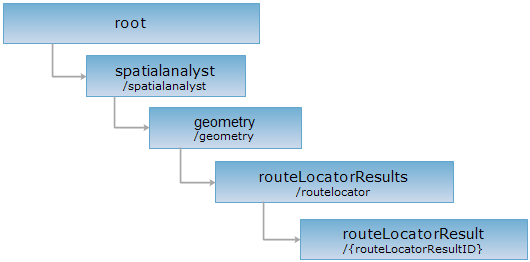URI
<routeLocatorResults_uri>/{routeLocatorResultID}[.<format>]
Supported methods
Parent resource
Introduction
Creates the route locater point (line) analysis result resource.
Supported Methods:
- GET: Returns the created route locater point (line) analysis result.
- HEAD: Checks whether routeLocatorResult resource exists, or whether it can be accessed.
Supported output formats: rjson, json, html, xml.
Resource hierarchy

HTTP request methods
Implement the HTTP request on the following URI, where supermapiserver is the server name, with rjson being the output format.
http://supermapiserver:8090/iserver/services/spatialanalyst-sample/restjsr/spatialanalyst/geometry/routelocator/ryw0x19a_478fb6d0164248c79e05fcb955a19dfe.rjson
GET request
Returns the created route locater point (line) analysis result.
Response structure
The response parameters are as follows after implementing the GET request on the routeLocatorResult resource.
| Field | Type | Description |
| succeed | boolean | Whether the analysis result have been created successfully. Returns true if successful; otherwise false. |
| image | ImageResult |
The route locater point (line) analysis result image, which represents the result image from SuperMap iServer Java spatial analysis and the description of the image. |
| message | String | Related information generated during route locater point (line) analysis. |
| resultGeometry | Geometry | The spatial analyst result geometry object. |
Response example
The returned rjson format representation of the routeLocatorResult resource after implementing the GET request on http://supermapiserver:8090/iserver/services/spatialanalyst-sample/restjsr/spatialanalyst/geometry/routelocator/ryw0x19a_478fb6d0164248c79e05fcb955a19dfe.rjson is as follows:
{
"image": null,
"message": null,
"resultGeometry": {
"center": {
"x": 3807.3544472261500,
"y": -6674.284687188670
},
"id": 0,
"parts": [1],
"points": [{
"x": 3807.3544472261500,
"y": -6674.284687188670
}],
"style": null,
"type": "POINT"
},
"succeed": true
}
HEAD request
Asks for the response identical to the one that would correspond to a GET request, but without the response body. This is useful for retrieving meta-information written in response headers, without having to transport the entire content. The meta-information includes the media-type, content-encoding, transfer-encoding, content-length, etc.
HEAD request can be used to check if the routeLocatorResult resource exists, or if the routeLocatorResult resource can be accessed by clients. It can also determine if the routeLocatorResult resource supports an output format <format> if performed on a URI with .<format> included.